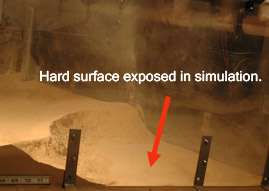Simulations predicted Mars lander would hit sub-surface

University of Michigan simulations correctly predicted that the pulsed jets of the Mars Phoenix lander would strip the soil to the subsurface ice or rock as the craft touched down.
Photos of the area beneath the craft on Friday revealed a hard surface that scientists say may be ice. It could also be rock, and researchers won’t know until the Phoenix can dig into the dirt. But it’s clear the craft cleared away soil as it landed.
“This is exactly what was predicted by our group,” said Nilton Renno, an associate professor in the Department of Atmospheric, Oceanic and Space Sciences. “We’ve seen the most amazing photos of the hard surface under the thrusters. The brightness and smoothness suggests it is ice.”
This would mark the first time a spacecraft has touched ice on another planet, Renno said.
Renno and Manish Mehta, a doctoral student in the same department, performed a series of tests for NASA over the past year in part to determine how the lander would affect the place it touches down. Phoenix’s pulsed jet steering and braking system is unique.
Mehta performed the most recent simulations in April at NASA Ames Research Center using properly-sized crushed walnut shells and other fine dust particles to simulate the Martian soil. Mehta showed that the pulsed jets could cause a different, more explosive erosion than the continuous jets of the Viking spacecraft, which landed on Mars in 1976. The Phoenix landing process involved thrusters firing in bursts to slow the craft and guide it.
“In our simulations, the pulsed jets excavated to the hard, icy surface within less than a second. The pulses fluidized the bed under the thrusters, so that the soil behaves like water, ” Mehta said.
These results were presented at the Phoenix Science Team Meeting at Tucson, Ariz. on May 19 and a site-alteration report was submitted to JPL and Lockheed Martin.
Mehta suggested to the Phoenix science team that they check under its deck on Mars to find exposed ice.
Phoenix landed on Mars on May 25 and will spend the next three months analyzing soil and ice to uncover the history of water on the planet. Its mission is to determine whether the arctic plains there could support microbial life.
Source: University of Michigan





















